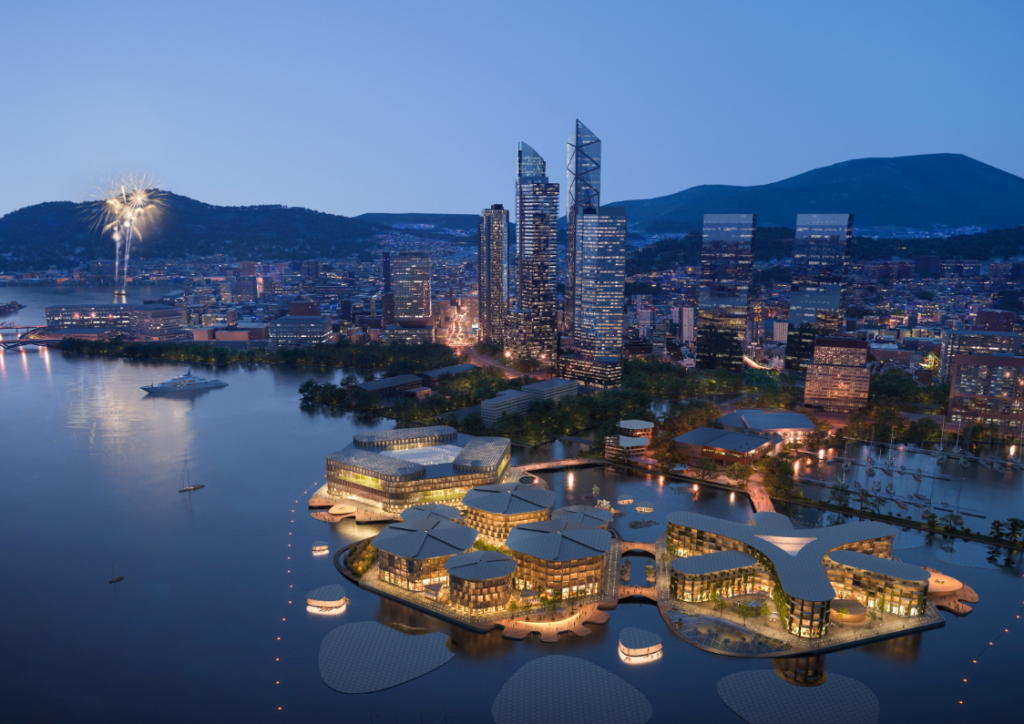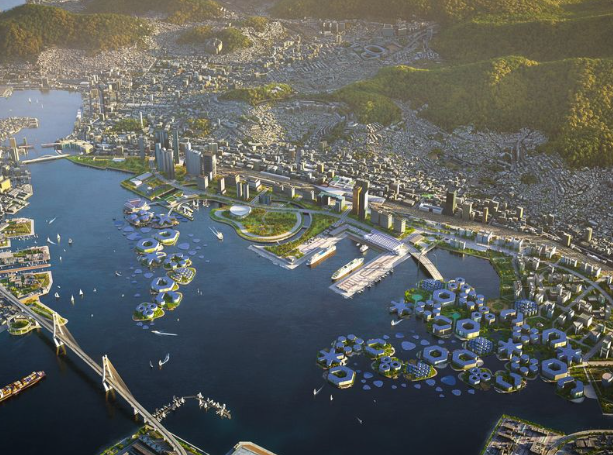An idea that was once a fantasy is making progress in Busan, South Korea. The challenge will be to design settlements that are autonomous and sustainable.

By: Adam Minter
View the original article here
Thanks to climate change, sea levels are lapping up against coastal cities and communities. In an ideal world, efforts would have already been made to slow or stop the impact. The reality is that climate mitigation remains difficult, and the 40% of humanity living within 60 miles of a coast will eventually need to adapt.
One option is to move inland. A less obvious option is to move offshore, onto a floating city.
It sounds like a fantasy, but it could real, later if not sooner. Last year, Busan, South Korea’s second-largest city, signed on to host a prototype for the world’s first floating city. In April, Oceanix Inc., the company leading the project, unveiled a blueprint.
It sounds like a fantasy, but it could real, later if not sooner. Last year, Busan, South Korea’s second-largest city, signed on to host a prototype for the world’s first floating city. In April, Oceanix Inc., the company leading the project, unveiled a blueprint.
Representatives of SAMOO Architects & Engineers Co., one of the floating city’s designers and a subsidiary of the gigantic Samsung Electronics Co., estimate that construction could start in a “year or two,” though they concede the schedule might be aggressive. “It’s inevitable,” Itai Madamombe, co-founder of Oceanix, told me over tea in Busan. “We will get to a point one day where a lot of people are living on water.”
If she’s right, the suite of technologies being developed for Oceanix Busan, as the floating city is known, will serve as the foundation for an entirely new and sustainable industry devoted to coastal climate adaptation. Busan, one of the world’s great maritime hubs, is betting she’s right.
A Prototype for Atlantis
Humans have dreamed of floating cities for millenniums. Plato wrote of Atlantis; Kevin Costner made Waterworld. In the real world, efforts to build on water date back centuries.
The Uru people in Peru have long built and lived upon floating islands in Lake Titicaca. In Amsterdam, a city in which houseboats have a centuries-long presence, a handful of sustainably minded residents live on Schoonschip, a small floating neighborhood, completed in 2020.
Madamombe began thinking about floating cities after she left her role as a senior adviser to then-UN Secretary General Ban Ki-Moon. The New York-based native of Zimbabwe had worked in a variety of UN roles over more than a decade, including a senior position overseeing partnerships to advance the UN’s Sustainable Development Goals. After leaving, she maintained a strong interest in climate change and the risks of sea-level rise.
Her co-founder at Oceanix, Marc Collins, an engineer and former tourism minister for French Polynesia, had been looking at floating infrastructure to mitigate sea-level risks for coastal areas like Tahiti. An autonomous floating-city industry seemed like a good way to tackle those issues. Oceanix was founded in 2018.
As we sit across the street from the lapping waves of Busan’s Gwangalli Beach, Madamombe concedes that they didn’t really have a business plan. But they did have her expertise in putting together complex, multi-stakeholder projects at the UN.
In 2019, Oceanix co-convened a roundtable on floating cities with the United Nations Human Settlements Program — or UN-Habitat — the Massachusetts Institute of Technology Center for Ocean Engineering and the renowned architectural firm Bjarke Ingels Group (better known as BIG). “The UN said there’s this new industry that’s coming up, it’s interesting,” Madamombe said. “They wanted to be able to shape the direction that it took and to have it anchored in sustainability.”
At the Oceanix roundtable, BIG unveiled a futuristic, autonomous floating city composed of clusters of connected, floating platforms designed to generate their own energy and food, recycle their own wastes, assist in the regeneration of marine life like corals, and house thousands.
The plan was conceptual, but the meeting concluded with an agreement between the attending parties, including UN-Habitat: Build a prototype with a collaborating host government. Meanwhile, Oceanix attracted early financial backers, including the venture firm Prime Movers Lab LLC.
Busan, home of the world’s sixth-busiest port, and a global logistics and shipbuilding hub, quickly emerged as a logical partner and location for the city. “The marine engineering capability is incredible,” Madamombe tells me. “Endless companies building ships, naval architecture. We want to work with the local talent.”
Busan’s mayor, Park Heong-joon, who is interested in promoting Busan as a hub for maritime innovation, shared the enthusiasm and embraced the politically risky project as he headed into an election. An updated prototype was unveiled at the UN in April 2022.
Concrete Platforms, Moored to the Seafloor
The offices of SAMOO, the Korean design firm that serves as a local lead on Oceanix Busan, are located high above Seoul. On a recent Monday morning, I met with three members of the team that’s worked closely with BIG, as well as local design, engineering and construction firms, to bring the floating city to life.
Subsidiaries of Samsung don’t take on projects that can’t be completed, and SAMOO wants me to understand that they’re convinced this project is doable. They also want me to understand that it’s important.
“Frankly, it’s not the floating-city concept we were interested in, but the fact that it’s sustainable,” says Alex Sangwoo Hahn, a senior architect on the project.
Floating infrastructure is nothing new in Korea. Sebitseom, a cluster of three floating islands in Seoul’s Han River, were completed in 2009 and are home to an event center, restaurants and other recreational facilities.
But they are not autonomous or sustainable, and they were not built to house thousands of people safely. Built from steel, they are likely to last years. But corrosion and maintenance will eventually be an issue.
Oceanix Busan must be more durable and stable. Current plans place it atop three five-acre concrete platforms that are moored to the seafloor, with an expected life span of 80 years. The platforms will be 10 meters deep, with only two meters poking above the surface. Within the platforms will be a vast space designed to hold everything from batteries to waste-management systems to mechanical equipment.
That’s a lot of space, but the design and engineering teams are learning that there’s never enough room to do everything. For example, indoor farming — an aspiration at Oceanix — requires large amounts of energy that must be devoted to other goals.
Dr. Sung Min Yang, the project manager on Oceanix Busan and an associate principal at SAMOO, acknowledges that — for now — the floating city won’t meet all its aspirations. “We hoped to be net positive with energy, we would recycle everything and not have any waste going out,” he says. “Now we are striving for net zero, but we are also looking at a backup connection to the mainland for electricity and wastewater.
Madamombe, who spends much of her time working out differences between the various teams involved in the project, isn’t bothered that some of the initial vision must be reined in. She recounts a piece of advice she received from advisers from the MIT Center for Ocean Engineering: “Don’t try to prove everything.” She shrugs. “If we grow 50% of our food and bring 50% in, will it be a great success?” she asks. “Yes, it would be. It’s a city!”
That wouldn’t be the only success. Creating three massive floating concrete platforms that can safely support multi-story buildings while recycling the wastes of residents (including water) would be a major technological advance, and one that Oceanix says that it — and its partners — can pull off, and profitably market. In time, the technologies will improve, becoming more autonomous and sustainable, in line with Oceanix’s earliest aspirations.
But first a prototype must be built. SAMOO estimates that constructing the first floating platforms will require two to three years as the contractors and engineers work out the techniques. Even under the best of circumstances, construction won’t start until next year at the earliest, putting completion — aggressively — mid-decade.
Costs are also daunting. Estimates for this first phase of Oceanix Busan range as high as $200 million and — so far — that funding hasn’t been secured. That will require private fundraising, including in Korea.
Madamombe says Busan will “help raise money by backing the project and making introductions,” not by contributions. But the slow ramp-up isn’t dissuading anyone. According to SAMOO, multiple Korean shipbuilding companies are interested in the project.
It’s a Start
Visionaries have long dreamed of floating cities that are politically autonomous, as well as resource autonomous. One day, that dream might be achieved. But for now, Oceanix is about developing technologies that help coastal communities adapt to climate change and persist as communities.
To do that, Oceanix Busan will be directly connected to Busan by a roughly 260-foot bridge. Rather than function as an autonomous city, it will instead function as a kind of neighborhood under the full administrative jurisdiction of Busan city hall.
Of course, three platforms and 12,000 planned residents and visitors won’t be enough to save Busan from climate change. Neither will the additional platforms that Oceanix hopes to see built and connected to the first three in coming years.
But it’s a start that can serve as a model and inspiration for other communities hoping to adapt to sea-level changes, rather than just respond to them. After all, disaster assistance and sea walls are expensive and require intensive planning, too.
Long term, humanity will need to learn to live with rising sea levels. Floating cities will be one way for coastal communities to do it.

